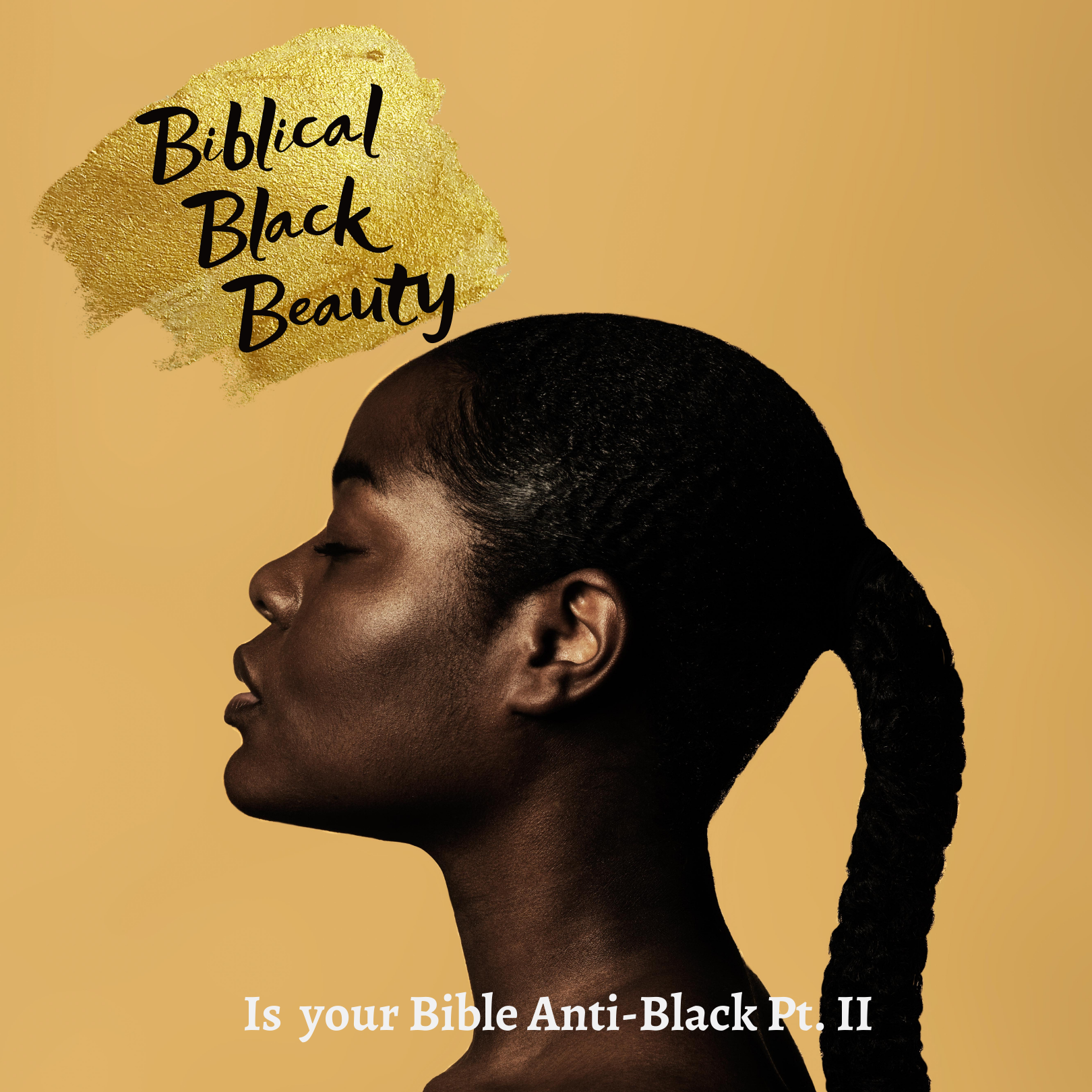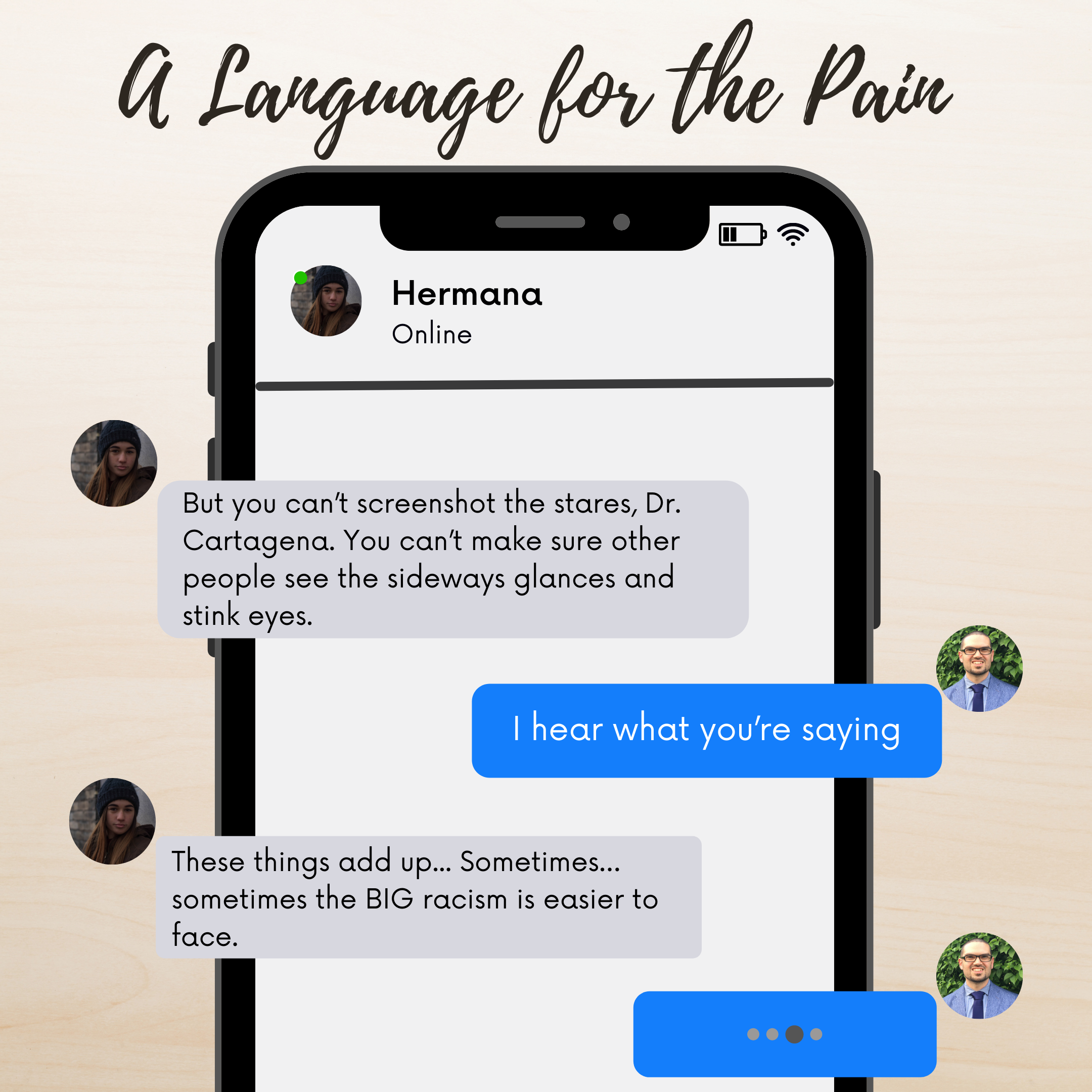Editors Note: Throughout this essay, “black” and “white” refers to the colors, while “Black” and “White” refer to historic racialized communities.
שְׁחוֹרָ֤ה אֲנִי֙ וְֽנָאוָ֔ה בְּנ֖וֹת יְרֽוּשָׁלָ֑יִם כְּאָֽהֳלֵ֣י קֵדָ֔ר
כִּֽירִיע֖וֹת שְׁלֹמֹֽה
אַל־תִּרְאֻ֨נִי֙ שֶֽׁאֲנִ֣י שְׁחַרְחֹ֔רֶת שֶׁשְּׁזָפַ֖תְנִי הַשָּׁ֑מֶשׁ בְּנֵ֧י אִמִּ֣י נִֽחֲרוּ־בִ֗י שָׂמֻ֨נִי֙ נֹֽטֵרָ֣ה אֶת־הַכְּרָמִ֔ים כַּרְמִ֥י שֶׁלִּ֖י לֹ֥א נָטָֽרְתִּי
—Song of Songs 1:5-6
This is essay two of two for the mini-series “Is Your Bible Anti-Black.” In the first essay, I engaged renowned Old Testament scholar Wilda Gafney’s critique of how the King James Version renders Song of Solomon 1:5. Whereas the original Hebrew literally reads “black am I and beautiful,” the KJV’s translators choose to write “I am black, but comely [beautiful].” Reflecting on this glaring difference, Gafney argues that the KJV’s translators “could not see blackness as beautiful, and so their whole identity [as self-identified white men] went into that one conjunction saying, ‘in spite of being Black, she’s all right.’ But that is not what the text said. And so that was the first place where I understood that people make choices when they translate [the Bible], and those choices affect what we hear [from the text].” The KJV’s rendering is wrong, Gafney contends, and layers anti-Black racist ideas onto the biblical page. Accepting Gafney’s argument, I extended her work by detailing the KJV’s cultural and racial context and noting how modern versions compare to it.
In this essay, I return to Song of Solomon to offer an interpretation of verses five and six. I again think with Dra. Gafney, following her lead as I listen to this ancient Song’s textual rhythms. Join us.
Setting the Stage: Song of Solomon 1:1-4
Song of Solomon shocks its readers. Whereas the song never explicitly mentions God, it repeatedly and exuberantly details human love. And this is not the love of mere friends. As Gafney observes, the text focuses on “the love of two people expressed sensuously, sexually.” More specifically, the song celebrates “the love of and between two black bodies—offered as scripture and revelation.”
The first black body the song introduces is the text’s lead woman. She is the focus of our passage and essay. And she immediately makes her romantic desires known.
May he kiss me with the kisses of his mouth!
For your love is sweeter than wine.Your oils have a pleasing fragrance,
Your name is like purified oil;
Therefore the young women love you.
Draw me after you and let’s run together!
The king has brought me into his chambers. (NASB, vv. 2-4)
Intoxicating kisses, fragrant oils, an alluring name, romantic flight, and a royal bed chamber—these are the Song’s opening themes.
The beloved declares her ballad publicly. She does not conceal her sensuous love. For immediately after we read her love song, an enthusiastic, supportive chorus enters the text, greeting us and the beloved with a celebration of her imminent sexual union.
We will rejoice in you and be joyful;
We will praise your love more than wine.
Rightly do they love you. (NASB, v. 4)
All are joyful. All rejoice. All celebrate a woman’s sensuality and sexuality. All are elated about the beloved’s foreshadowed lovemaking with her beloved.
A Beautiful Black Woman: Song of Solomon 1:5
This women that the chorus celebrates as rightly loved, what does she look like? Verse five tells us.
I am black and beautiful,
You daughters of Jerusalem,
Like the tents of Kedar,
Like the curtains of Solomon. (NASB, v. 5)
As noted above, the Hebrew text literally reads “black am I and beautiful” (שְׁחוֹרָ֤ה אֲנִי֙ וְֽנָאוָ֔ה). The order matters. As Gafney writes, the verse “emphasizes [the woman’s] blackness by opening with it.” Gafney makes a related point elsewhere: When describing the woman—the one her beloved declares the “most beautiful among women” (v.8)— “[b]lack is the first word.”
Like her beloved, the Song’s lead woman champions that black is beautiful. “I am black and beautiful.” The word “and” translates the text’s vav conjunction וְֽ at the start of וְֽנָאוָ֔ה. This basic conjunction stresses blackness’s inherent beauty. Indeed, Rabbi Marcia Falk’s translation conveys the text’s tone: “Yes, I am black! And radiant/O city women watching me.”
The Song’s lead women again highlights her blackness in verse five by comparing it to the tents of Kedar, or Qedar, and Solomon’s curtains. This analogy, Gafney notes, reveals that the women’s body “is blacker than your average brown-to-black ancient Afro-Asiatic person.” The reference to Qedar tells readers that the woman “is black as a black-haired goat.” As Gafney explains, the Song’s woman is “as black as the black goats’ hair tents woven from the famed goats of Qedar renowned for their beautiful black coats in antiquity.” Gafney’s use of “renowned” is important. As Old Testament scholar Aubrey Buster notes, the Qedar’s tents and Solomon’s curtains “were considered to be striking and beautiful” in the woman’s culture. Hence, the Song’s lead woman affirms that her blackness is strikingly beautiful, worthy of renown and communal adulation like Qeadar’s tents and Solomon’s curtains. Thus, verse five starts and ends by emphasizing the woman’s beautiful black body.
Many commentators and translators miss verse five’s celebration of blackness. Gafney laments this trend among translators:
[A] myriad of bible translators continuing into modernity persist with “I am black/dark but beautiful/comely/lovely.” Blackness and beauty cannot occupy the same space in the imaginations so they cannot occupy the same space in their translations, no matter what the text actually says. (emphasis added)
Numerous translators render verse five’s opening vav conjunction “but,” not “and.” This interpretive choice injects an aesthetic distance between blackness and beauty. Nothing in verse five requires this distance. Moreover, and more important: the conjunctive-vav’s common “and” meaning and the positive, culturally loaded invocations of beautiful black goats, tents, and curtains provide immediate linguistic and contextual grounds against this disjunctive, distancing reading.
One respected Old Testament scholar overlooks the previous two points. Tremper Longman argues that readers face a choice at verse five: “Should we translate the waw as a conjunctive ‘and’ or a disjunctive ‘but”?” For Longman, the answer is simple. “The context is actually quite clear. She is not happy with her darker-than-normal skin, so the disjunctive makes sense.” The contrast between Longman’s reading and those of Gafney and Falk is striking. So is Longman’s silence about the rest of verse five. He says nothing about Qeadar’s tents and Solomon’s curtains. It’s as if they weren’t there.
Gafney, Buster, and Falk read verse five as celebrating blackness and its beauty. Longman reads it as lamenting “darker-than-normal skin.” If verse five doesn’t’ drive Longman’s interpretive decision and commentary, what does? His reading of verse six.
Sun Gazed: Song of Solomon 1:6
Desire and joy fill verses two through five. A choir praises the woman after her opening declaration of longing to be with her beloved. Then the woman celebrates her blackness. She is black and beautiful like Qeadar’s famous tents and Solomon’s splendid curtains. Given the prevalence of parallelism in Hebrew songs and poetry, we might expect the chorus to support the woman’s celebration of blackness with their own hymn of praise. But the text doesn’t meet this expectation. Instead, it introduces the Song’s first rebuke.
The translation I’ve used throughout renders verse six thus:
Do not stare at me because I am dark,
For the sun has tanned me.
My mother’s sons were angry with me;
They made me caretaker of the vineyards,
But I have not taken care of my own vineyard. (NASB, emphasis in translation)
This translation doubly obscures verse six’s first sentence. The word translated “dark” carries the connotation of “black” from verse five. Likewise, the sentence contrasts people’s staring/looking with the sun’s staring/looking. The KJV captures both details: “Look not upon me, because I am black, because the sun hath looked upon me.” Still, the word “stare” better expresses the Hebrew meaning involved in the woman’s rebuke-saturated command to the daughters of Jerusalem. Gafney writes, “It seems the city-women can’t keep their eyes off of her. They keep staring, looking her up and down.” These stares aim to pierce, penetrate, and judge. Again Gafney:
The shout out to the daughters of Jerusalem is an acknowledgement that our bodies are always under scrutiny. We are weighed and measured, consumed and labeled acceptable or defective in a glance. The black beauty Shahorah—we can call her Ebony, Raven, Jet or Onyx—Shahorah says you call me black like that’s an insult. Let me tell you, I am black, as silky-black as the luxurious coat of a Kedari goat, like mink, only blacker.
The Song’s lead woman told the daughters of Jerusalem that she was black and beautiful in verse five. Now she tells them, Gafney writes, “don’t stare at me because my beautiful black skin has gotten even darker while I bask in the sun.”
The sun gazed upon the Song’s black woman and made her darker, gave her a tan. Some modern readers assume that the text’s implied talk of tanning entails that the Song’s lead woman is but a white woman with a tan. This reading projects a white normative gaze onto the text and ignores verse five’s repeated discussion of rich blackness. It also elides the truth that black-skinned people tan. Gafney discusses personally suffering this elision.
I am regularly asked to give an account of my presumptively alternate biology, imagined to be fundamentally different from the interrogator’s own normative experience of being human.
“Can you tan?”
“Do you burn?”
I am expected to answer when questioned. To explain myself and my race. Public access to my body is unquestioned.
And deeply entangled with the notion of otherness is the notion of beauty.
The false assumption that Black people don’t tan which regularly confronts Gafney also occupies a place in study bibles. As Gafney recalls, “Some say...doesn’t verse 6 say that she is sunburned, therefore, she can’t be black – that’s what the notes in my study bible says.” For some readers, “being black and sunburned [is] impossible, as impossible as being black and beautiful” (emphasis in original). Even Tremper Longman joins Gafney in rejecting the assumption that the Song’s lead female is a tanned or sunburned white woman. “The woman was Semitic and likely had a dark complexion to start with. The darkness about which she complains is not her natural skin color but a tan or burn.”
Yet the differences between Longman’s and Gafney’s readings remain sharp. Longman says that the woman “likely had a dark complexion to start with.” Gafney, following verse five’s emphasis on the woman’s blackness, highlights that the woman was black and “revels in the blackness of her skin.” Longman says that the woman “complains” about her “tan or burn.” Though Gafney acknowledges that “the woman in the text ruined her beautiful black Qedari complexion with a sunburn,” Gafney never says that the woman complains about her sunburn. Instead, Gafney says that the woman “embraces the kiss of the sun” while denouncing the Jerusalem women’s glares and how her family treated her. The women’s glares are “reminder[s] that everyone won’t look at [black skinned people] and see the glory that God created.” These glares carry negative class associations with field labor. And her family’s mistreatment of her has left the Song’s lead woman unable to care for her own vineyard—for herself.
Let’s unpack the previous point. Verse six’s second half reads:
My mother’s sons were angry with me;
They made me caretaker of the vineyards,
But I have not taken care of my own vineyard. (NASB)
Though the woman claims her mother, she doesn’t claim her brothers. They are “my mother’s sons.” Similarly, although the woman says her mother’s sons were angry with her, she doesn’t explain why. The text doesn’t say she did anything wrong. It does, however, stress that these sons made her care for the vineyards. The joy of agency is missing; the cruelty of coercion is present instead.
This is not the only time the Song’s lead woman describes her “brothers” controlling her body. In the Song’s final chapter, we read them saying:
We have a little sister,
And she has no breasts;
What shall we do for our sister
On the day when she is spoken for?If she is a wall,
We will build on her a battlement of silver;
But if she is a door,
We will barricade her with planks of cedar. (NASB, 8:8-9)
In these verses, men alone speak. We do not hear the Song’s lead woman discussing her body. We do hear the men referring to the woman’s genitals as a “wall” (i.e., premarital chastity) and a “door,” a common Near Eastern image that alluded to a prostitute. As Gafney writes, the “brothers” work “to constrain and confine her.”
And this male coercion returns us to it’s first appearance in the song, verse six. For there we read that the lead woman has not cared for her own vineyard—her own body. Because her “brothers” forced her to labor outdoors, the sun burned her. It harmed her beautiful black body. And in act of resistance, the woman rebukes the Jerusalem’s daughters for trying to inflict similar pain by staring at her. She is black. She is beautiful. She is unashamed of herself and refuses to internalize negative class associations with field labor. And she is tending to her vineyard, she is loving her body and her beloved. “It is time,” Gafney writes, “to tend our own vines and their sweet, luscious, intoxicating fruit.”
Conclusion
Let’s consider one final contrast between Longman’s and Gafney’s readings. Longman argues that “In spite of some ambiguities, [Song of Song 1:5-6] is clear about two matters: (1) the woman considers her dark skin unattractive, and (2) her dark skin is not her natural skin color but rather the result of a tan.” Both claims run afoul of verse five’s celebration of blackness, which verse six never negates. Taken together, Gafney argues, these verses teach that “Black is beautiful. Blackness is beauty. Blackness is worshipful. All blackness is divine. It is the imprint of the holy darkly radiant God in whose image we are created.”
About Dr. Nathan Luis Cartagena
A son of the US South (Mom) and Puerto Rico (Dad), Dr. Cartagena is an Assistant Professor of Philosophy at Wheaton College (IL), where he teaches courses on race, justice, and political philosophy, and is a fellow in The Wheaton Center for Early Christian Studies. He serves as the faculty advisor for Unidad Cristiana, a student group working to enhance Christian unity and celebrate Latina/o cultures, a scholar-in-residence for World Outspoken, and a co-host for the forthcoming podcast From the Underside. He’s also writing a book on Critical Race Theory with IVP Academic.
Articles like this one are made possible by the support of readers like you.
Donate today and help us continue to produce resources for the mestizo church.











